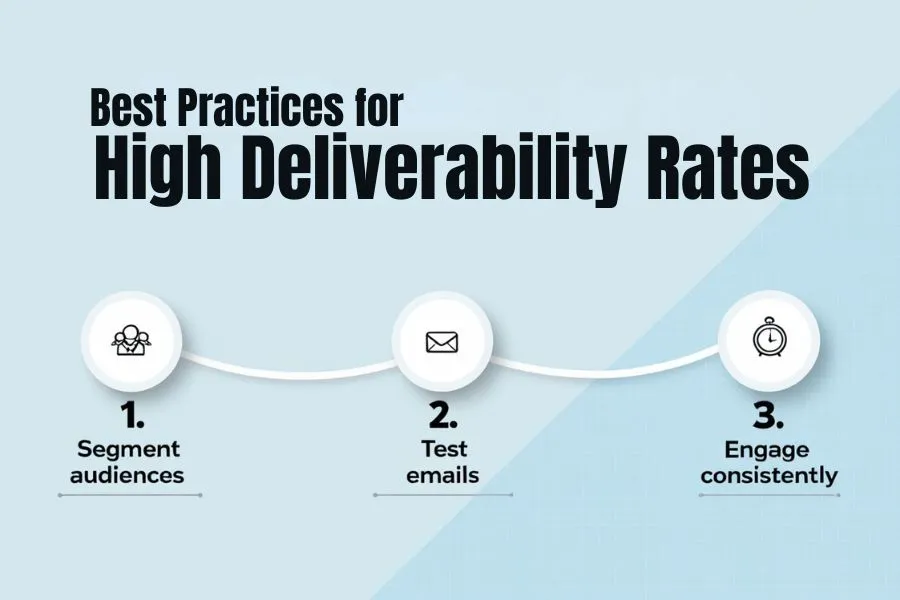Table of Contents
Email deliverability is a cornerstone of successful email marketing, yet it often gets overshadowed by flashy subject lines and creative content. In this comprehensive guide, we’ll break down critical elements like spam filters, email reputation, bounce rates, DKIM, and domain authentication to ensure your messages land exactly where you intend.
Introduction to Email Deliverability
Email deliverability measures the success of your emails reaching recipients’ inboxes instead of their spam folders. It’s more than just sending messages; it’s about building trust, maintaining technical standards, and understanding how your practices impact inbox placement.
For example, even a stellar email campaign can falter due to poor domain authentication or a high bounce rate. Companies like Mailchimp have detailed guidelines to help businesses maximize deliverability.
What Are Spam Filters?
Spam filters are automated tools that protect inboxes from unwanted emails. They evaluate incoming emails based on various criteria like sender reputation, content quality, and authentication.
Types of Spam Filters
- Content-Based Filters: Analyze email body and subject line for spammy words.
- Header Filters: Inspect email metadata, such as “From” addresses.
- Permission Filters: Check whether recipients have opted in.
How to Avoid Spam Filters
- Use clean email lists with active subscribers.
- Avoid trigger words like “FREE” or “BUY NOW.”
- Ensure your domain is authenticated (we’ll discuss this later).
Email Reputation
Your email reputation is related to your credit score for email senders. Internet Service Providers (ISPs) use it to decide whether your emails should be delivered, blocked, or sent to spam.
Factors Affecting Email Reputation

- Sending History: Consistency matters.
- Spam Complaints: high complaints can damage reputation.
- Bounce Rates: Frequent delivery failures signal poor practices.
Improving Your Email Reputation
- Warm up new domains by sending emails to engaged users first.
- Regularly clean your email lists to remove inactive addresses.
- Monitor your reputation using tools like Sender Score.
Bounce Rates: Hard vs. Soft Bounces
Bounces occur when emails fail to reach recipients. They’re categorized into two types:
- Hard Bounces: Permanent failures due to invalid email addresses.
- Soft Bounces: Temporary issues like your email inboxes are full or server-down errors.
Reducing Bounce Rates
- Check email addresses are accurate before adding in the list.
- Resend soft bounces after a short interval.
- Use double opt-in methods for new subscribers to verify.
The Role of DKIM in Email Deliverability
DomainKeys Identified Mail (DKIM) is an email authentication protocol that allows senders to sign their emails digitally. This ensures the integrity and authenticity of your messages.
How DKIM Works
- Use digital signature in email header.
- ISPs verify the signature for DNS records.
Benefits of DKIM
- Reduces the chances of email spoofing.
- Builds trust with ISPs, enhancing deliverability.
Domain Authentication
Domain authentication ensures emails from your domain. Common methods include:
- SPF (Sender Policy Framework): On behalf of your domain, limits who can send emails.
- DKIM: Confirms message integrity.
- DMARC (Domain-based Message Authentication, Reporting, and Conformance): Aligns SPF and DKIM policies to protect your domain from abuse.
How to Check Email Deliverability
Monitoring email deliverability helps identify issues early. Tools like:
1. MXToolbox
Purpose: MXToolbox checks your domain’s authentication records (SPF, DKIM, DMARC). These records help validate your emails and prevent them from being marked as spam.
How to Use:
- Sign up for a free account.
- Enter your domain name.
- Analyze the report: Check for errors in your SPF, DKIM, and DMARC records.
- Fix any issues: Consult with your IT team or email service provider to correct the errors.
2. Mailtrap
Purpose: Mailtrap simulates inbox placement tests to see how your emails are categorized by different email providers.
How to Use:
- Sign up for a free account.
- Configure your email sending server to send test emails to Mailtrap.
- Send test emails to different email providers.
- Analyze the results: Check if your emails are landing in the inbox, spam, or promotions folders.
3. Google Postmaster Tools
Purpose: Google Postmaster Tools tracks your domain’s reputation with Google. It provides insights into your email delivery performance.
How to Use:
- Sign up for a free account.
- Add and verify your domain.
- Monitor your domain’s reputation: Check for any issues with spam complaints, bounces, or authentication failures.
- Improve your email practices: Take steps to address any issues identified in the reports, such as cleaning your email list and improving your email content.
Common Mistakes That Affect Deliverability
- Ignoring unsubscribe requests.
- Using purchased email lists.
- Sending emails with broken links or images.
Best Practices for High Deliverability Rates

1. Segment Audiences: Create content to specific groups.
Example 1: Instead of sending a generic “New Product Launch” email to your entire list, segment your audience based on purchase history, demographics, or interests. Send a targeted email to customers who have previously purchased similar products, highlighting the features they’re most likely to appreciate.
2. Test Emails: Ensure proper formatting and load times.
Example 1: Before sending a major campaign, send a test email to a small group of subscribers to check for formatting errors, broken links, or images that aren’t displaying correctly.
3. Engage Consistently: Avoid long gaps between campaigns.
Example 1: Instead of sending sporadic emails, create a regular email schedule with consistent content. For example, send a weekly newsletter with curated industry news, company updates, and exclusive offers.
Email Marketing Basics: Email Campaigns, Newsletters, Open Rates, & CTR
Email marketing jobs remote: No Experience, Part Time Work From Home or Worldwide 2024
Email Automation: Drip Campaigns, Workflows & Tools
FAQs About Email Deliverability
1. What is email deliverability?
Email deliverability is the ability of your emails to reach inboxes instead of spam folders.
2. How do spam filters work?
Spam filters assess factors like sender reputation, content, and authentication to decide email placement.
3. What is DKIM?
DKIM is an email authentication method ensuring message integrity.
4. How can I reduce bounce rates?
Validate email addresses, resend soft bounces, and clean your lists regularly.
5. What tools help improve deliverability?
Tools like MXToolbox and Mailtrap provide insights into deliverability metrics.

